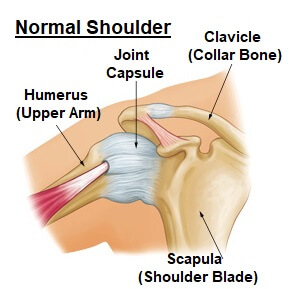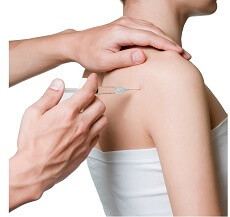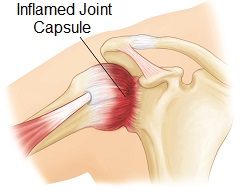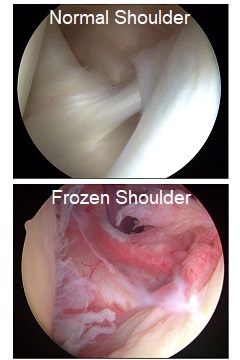
Frozen Shoulder - Treatment options
Shoulder movement is often greatly restricted in all directions with a frozen shoulder also known as adhesive capsulitis, and pain can be constant and severe, particularly at night.
The cause of this adhesive capsulitis is often unclear but may be linked to injury or illness. Normal daily activities such as driving and dressing, combing hairs are often affected and sleep may be very disturbed.
Approximately 3% of the population will suffer from a frozen shoulder at some point in their life, but the good news is that it is a self-limiting condition, which means it will eventually get better by itself. However, without a proper frozen shoulder treatment, it can take up to two years or more to fully recover from this pain and stiffness.
What Is A Frozen Shoulder?
The shoulder joint is a ball & socket type of joint. The ball is formed by the top of your humerus and sits in a shallow socket formed by part of the shoulder blade known as the glenoid fossa of scapula bone.
Surrounding the joint is a loose tissue known as the joint capsule which is full of fluid that helps to lubricate the joint. The capsule is normally an extremely elastic structure that allows a great range of movement at the shoulder.
With a frozen shoulder, the joint capsule becomes thickened and stiff, scar tissue forms and as the capsule tightens up, shoulder movement becomes more and more restricted and painful with time.
Causes of Frozen Shoulder
In most cases, adhesive capsulitis develops without a clear cause. However, there are some predisposing factors:
- Trauma: A frozen shoulder may develop after a shoulder injury or even a hand injury, even a minor one
- Surgery: After lung or breast or chest surgery
- Medical Conditions: More common in people who suffer from Diabetes, hypothyroid, heart disease & stroke
- Age & Gender: adhesive capsulitis is most common between the ages of 45-70 and is more prevalent in women. Almost 70% of cases affect women aged 40-60
Symptoms of Frozen Shoulder Symptoms
Frozen shoulder symptoms develop gradually and progressively gets worse. The most common symptoms of adhesive capsulitis are pain and stiffness. Frozen shoulder typically goes through three sequential phases:
Phase 1: Freezing Phase. Pain is the primary symptom here, particularly with any movement of the arm and at night. The pain gets progressively worse over time and the shoulder gradually stiffens and movement becomes restricted in all directions. This phase usually lasts anywhere from 2 to 9 months.
Phase 2: Frozen Phase. Stiffness is the primary symptom here, and shoulder movement may be less than half that of the other arm. The pain gradually gets better during this phase but the stiffness persists and may even get worse with time. This phase may last 4-12 months. Treatment may be most effective during this phase as the pain starts to settle down a bit.
Phase 3: Thawing/Recovery Phase. In this phase symptoms will gradually ease and regain full (or almost full) range of motion at your shoulder with little or no pain. This phase can last between 6 months to 36 months
Frozen shoulder more commonly develops in your non-dominant hand i.e. in a right-handed person, more likely to develop a frozen shoulder in your left arm. It usually only affects one shoulder only, but in 20% of the cases, people go on to develop frozen shoulder in their other shoulder.
Diagnosis of Adhesive Capsulitis
A frozen shoulder can usually be diagnosed by your doctor or physiotherapist. The doctor will look at the range of movement at your shoulder as you move the shoulder (known as active movement) and then compare it to how much they can move your arm while they support its weight (known as passive movement).
FROZEN SHOULDER VS ROTATOR CUFF TEAR
Treatment of Frozen Shoulder
Frozen shoulder treatment helps to reduce both pain and restriction as well as speed up the recovery process. If no treatment is taken, adhesive capsulitis normally resolves after around two years.
Treatment of Shoulder Pain in HINDI
Frozen shoulder treatment will depend on the severity of your condition and in what phase you are there.
Phase 1: Most painful phase so frozen shoulder treatment will focus on controlling the pain. It is important that you keep moving and using the shoulder to prevent further stiffness from developing but without irritating your shoulder joint during this phase.
Phase 2 & 3: As the pain starts to settle, treatment focusses on regaining range of movement and strength for shoudler.
1. Painkillers
It is really important to get and keep the pain under control to make the shoulder more comfortable, allow you to sleep, and to enable you to start other frozen shoulder treatments such as exercise. Always consult your treating doctor before taking any medications like NSAIDS etc.
2. Shoulder Steroid Injections

Few patients with unbearable pain may require injections in the shoulder joint. Injections are not able to cure the problem long-term, still, they can help to reduce the symptoms for a few weeks or months which can be a welcome relief.
Steroid injection in Shoulder pain in HINDI
3. Heat/Ice
Using ice packs or heat pads can help to reduce the pain associated with frozen shoulder. Some people prefer heat, others prefer ice – you can use which works best for you.
4. physical Therapy
Physiotherapy for frozen shoulder will depend on which phase you are in.
Exercise for frozen Shoulder in Hindi
Phase 1: Focus here is on gentle exercises to maintain your range of movement and to help prevent the restriction from getting worse, without pushing into pain. These exercises should be repeated 2-3 times daily. You may also be given a TENS (transcutaneous electric nerve stimulator) which sends small electric pulses into your tissues, to help reduce the pain of the disease.
Phase 2: Now we need to concentrate on regaining movement. Stiffness is the primary problem at this phase and the pain is starting to diminish you will be encouraged to push your shoulder movements gradually more with a range of exercises. It is important to repeat these exercises 2-3 times daily.
Your physiotherapist must also perform joint mobilisations & stretches, where they move your shoulder to help regain movement. These may be uncomfortable sometimes, but any discomfort should settle within a few minutes of exercises.
Phase 3: You need to continue with your daily exercise programme gradually aiming to regain more and more movement of your shoulder joint. Your physiotherapist needs to focus to increase both the movement and strength in your shoulder. You should repeat these exercises until you have made a full recovery from this. It is always tempting for you to stop doing these exercises when you feel around 80% better, but if you keep going, you should regain that last 20% much faster.
5. Frozen Shoulder Surgery
If your symptoms are severe and not improving after approximately six months, your doctor may recommend surgery.
Arthroscopic Capsular Release: It is a keyhole surgery with general anaesthesia (so you are asleep) to cut through tight or scarred tissues to release the capsule of the tight shoulder joint.
Arthroscopic Hydrodilatation: It is again keyhole surgery under local anaesthesia (so you are awake) where the shoulder joint is injected with a mixture of sterile saline, local anaesthetic and steroid. This fills and stretches the tight shoulder joint, breaking down the scar tissue around the joint.
MUA (Manipulation Under Anaesthesia): where you are put to sleep under anaesthesia and an orthopaedic doctor moves your shoulder in a controlled way to stretch the tight joint capsule.
Whatever surgery you have been through it is very importnat that it is followed by intensive physiotherapy so that you maintain and regain shoulder movement.
Recovery & Prevention
With or without frozen shoulder treatment, this will usually settle of its own course after around 2 years. But if you want to get the relief sooner, and minimize symptoms as much as possible, you may undergo frozen shoulder treatments. Most people regain at least 90% of their shoulder joint movement.
Prevention is often very difficult due to the cause of frozen shoulder being largely unknown, the most vital thing is to keep your shoulder moving. This is particularly important after an injury or surgery as per your doctor's advice.
Best shoulder pain doctor in Jaipur India
Best Shoulder pain surgeon doctor in Jaipur India
No Comment Available

